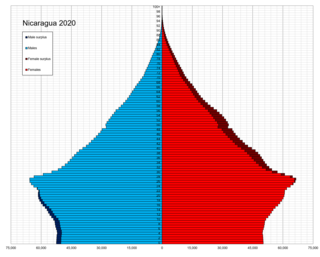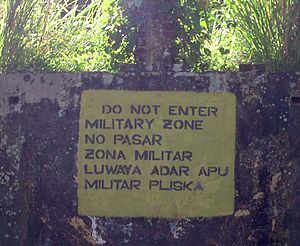
According to the 2022 revision of the World Population Prospects, Nicaragua has a population of 6,850,540. Whites and Mestizos and tribally unaffiliated Native Americans combined make up about 56% of the population. The remainder of the Nicaraguan population is 9% English-speaking Afro-Nicaraguans, and 33% Tribal Native American.

The North Caribbean Coast Autonomous Region is one of two autonomous regions in Nicaragua. It was created along with the South Caribbean Coast Autonomous Region by the Autonomy Statute of 7 September 1987 through a division of the former Zelaya Department. It covers an area of 33,106 km2 and has a population of 541,189. It is the largest autonomous region or department in Nicaragua. The capital is Puerto Cabezas. It contains part of the region known as the Mosquito Coast.

Mesoamerican languages are the languages indigenous to the Mesoamerican cultural area, which covers southern Mexico, all of Guatemala and Belize and parts of Honduras and El Salvador and Nicaragua. The area is characterized by extensive linguistic diversity containing several hundred different languages and seven major language families. Mesoamerica is also an area of high linguistic diffusion in that long-term interaction among speakers of different languages through several millennia has resulted in the convergence of certain linguistic traits across disparate language families. The Mesoamerican sprachbund is commonly referred to as the Mesoamerican Linguistic Area.

Nicaraguans are people inhabiting in, originating or having significant heritage from Nicaragua. Most Nicaraguans live in Nicaragua, although there is also a significant Nicaraguan diaspora, particularly in Costa Rica and the United States with smaller communities in other countries around the world. There are also people living in Nicaragua who are not Nicaraguans because they were not born or raised in Nicaragua nor have they gained citizenship.

The Oto-Manguean or Otomanguean languages are a large family comprising several subfamilies of indigenous languages of the Americas. All of the Oto-Manguean languages that are now spoken are indigenous to Mexico, but the Manguean branch of the family, which is now extinct, was spoken as far south as Nicaragua and Costa Rica. Oto-Manguean is widely viewed as a proven language family. However, this status has been recently challenged.

The Misumalpan languages are a small family of languages spoken by indigenous peoples on the east coast of Nicaragua and nearby areas. The name "Misumalpan" was devised by John Alden Mason and is composed of syllables from the names of the family's three members Miskito, Sumo languages and Matagalpan. It was first recognized by Walter Lehmann in 1920. While all the languages of the Matagalpan branch are now extinct, the Miskito and Sumu languages are alive and well: Miskito has almost 200,000 speakers and serves as a second language for speakers of other indigenous languages in the Mosquito Coast. According to Hale, most speakers of Sumu also speak Miskito.

This is a list of different language classification proposals developed for the Indigenous languages of the Americas. The article is divided into North, Central, and South America sections; however, the classifications do not correspond to these divisions.
Mískito Coast Creole or Nicaraguan Creole English is an English-based creole language spoken in coastal Nicaraguan region of Mosquito Coast on the Caribbean Sea; its approximately 40,000 speakers are spread over the RAAN and RAAS regions of Nicaragua. The region, known before 1986 as the Zelaya department, is today administratively separated into two autonomous regions: North Caribbean Coast (RAAN) and South Caribbean Coast (RAAS). Mosquito is the nickname that is given to the region and earlier residents by early Europeans who visited and settled in the area. The term "Miskito" is now more commonly used to refer to both the people and the language.

Miskito is a Misumalpan language spoken by the Miskito people in northeastern Nicaragua, especially in the North Caribbean Coast Autonomous Region, and in eastern Honduras.

The Mayangna are a people who live on the eastern coasts of Nicaragua and Honduras, an area commonly known as the Mosquito Coast. Their preferred autonym is Mayangna, as the name "Sumo" is a derogatory name historically used by the Miskito people. Their culture is closer to that of the indigenous peoples of Costa Rica, Panama, and Colombia than to the Mesoamerican cultures to the north. The Mayangna inhabited much of the Mosquito Coast in the 16th century. Since then, they have become more marginalized following the emergence of the Miskito as a regional power.

Tlapanec, or Meꞌphaa, is an indigenous Mexican language spoken by more than 98,000 Tlapanec people in the state of Guerrero. Like other Oto-Manguean languages, it is tonal and has complex inflectional morphology. The ethnic group themselves refer to their ethnic identity and language as Me̱ꞌpha̱a̱.
Subtiaba is an extinct Oto-Manguean language which was spoken on the Pacific slope of Nicaragua, especially in the Subtiaba district of León. Edward Sapir established a connection between Subtiaba and Tlapanec. When Lehmann wrote about it in 1909 it was already very endangered or moribund.
Popoluca is a Nahuatl term for various indigenous peoples of southeastern Veracruz and Oaxaca. Many of them speak languages of the Mixe–Zoque family. Others speak the unrelated Mazatecan languages, in which case the name in English and Spanish is generally spelled Popoloca.
The Supanecan or Tlapanecan languages are Tlapanec (Me'phaa) of Guerrero and the extinct Subtiaba of Nicaragua. The family was recognized in 1925 by Edward Sapir, who linked them to his Hokan proposal. However, they are the most recently recognized members of the Oto-Manguean language family, the relationship having been demonstrated in 1977 by Jorge Suárez. The Oto-Manguean affiliation of Tlapaneco-Subtiaba is supported by Kaufman (2016).
Mangue, also known as Chorotega, is an extinct Oto-Manguean language ancestral to Nicaragua, Honduras and Costa Rica. Estimates of the ethnic population vary widely, from around 10,000 in 1981, to 210,000 according to Chorotega activists. Chorotega-speaking peoples included the Mangue and Monimbo. The dialects were known as: Mangue proper in western Nicaragua, which was further subdivided into Dirian and Nagrandan; Choluteca in the region of Honduras' Bay of Fonseca; and Orotiña in Costa Rica's Nicoya Peninsula.
Rama Cay Creole is a Creole language spoken by some 800 to 900 people on the island of Rama Cay in eastern Nicaragua. It is based on Miskito Coast Creole with additional elements of the Chibchan language Rama and purportedly some elements of English spoken with a German accent. The creolization of the language is supposed to have happened when Moravian missionaries who were native Germans but preached in English encouraged the Rama-speaking population of the island to shift to English.
The extinct Manguean languages were a branch of the Oto-Manguean family. They were Chorotega of Costa Rica and Nicaragua, and Chiapanec of Mexico.

Nicaraguan Spanish is geographically defined as the form of Spanish spoken in Nicaragua. Affectionately, Nicaraguan Spanish is often called Nicañol.

Afro-Nicaraguans are Nicaraguans of Sub-Saharan African descent. Five main distinct ethnic groups exist: The Creoles who descend from Anglo-Caribbean countries and many of whom still speak Nicaragua English Creole, the Miskito Sambus descendants of Spanish slaves and indigenous Central Americans who still speak Miskito and/or Miskito Coast Creole, the Garifunas descendants of Zambos expelled from St. Vincent who speak Garifuna, the Rama Cay zambos a subset of the Miskito who speak Rama Cay Creole, and the descendants of those enslaved by the Spanish.














